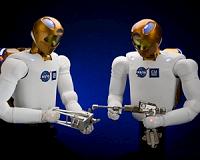 |
Washington (AFP) Aug 7, 2010 Two International Space Station astronauts set out Saturday on the first of two spacewalks to fix a cooling pump that dramatically failed last week. ISS astronauts will need at least two spacewalks to remove the failed ammonia pump unit and replace it with a new one after the device failed a week ago. Doug Wheelock and Tracy Caldwell Dyson slept in the Quest airlock module overnight to accommodate their bodies to a different pressure and were awakened at about 2:00 am (0600 GMT) to begin final preparations for their work. They activated battery power and other life-support systems inside their spacesuits, and opened the hatch at 7:19 am (1119 GMT), a procedure that officially marked the beginning of their seven-hour walk. The beginning of the walk was slightly delayed because of what was described by US space officials as a "communication problem" inside Caldwell Dyson's helmet. The problem has been successfully resolved, the official said. The first spacewalk will focus on removing the ammonia pump module that failed last Saturday and putting its replacement in place, according to officials from the National Aeronautics and Space Administration. A second spacewalk is planned Wednesday to connect fluid ammonia lines to the replacement pump. Mission managers plan a final review of that plan early next week, incorporating updated information on the station's configuration after the first spacewalk, NASA officials said. The spacewalks are challenging because the crew will be handling ammonia lines at full operating pressure, which makes the lines stiff during reconnection and mating, experts warned. The timeline for the spacewalk will require numerous "break-out points" to ensure adequate time to complete decontamination procedures if the crew comes in contact with ammonia. Once the failed unit has been removed, the two astronauts will have to move a 780-pound (355 kilograms) spare unit around 30 feet (10 meters) from the opposite side of the truss for insertion into the gap left by the defective pump module. "This is a big, unwieldy object, so maneuvering it around and handing it off to crew members... could take some time and a lot of focus," Courtenay McMillan, the spacewalk flight director for the expedition, told reporters earlier in the week. But robotics experts have devised procedures that will be used by station crew member Shannon Walker to guide the station's robotic arm, Canadarm2, from the robotics workstation in the Destiny Laboratory. She will move Wheelock into position to swap the failed unit with the spare unit, stored on an external stowage platform. That spare parts carrier is attached to the Quest airlock that Wheelock and Caldwell Dyson will use to exit and reenter the station. The crew faced a very tight lead time for such a tricky spacewalk -- less than a week when NASA usually takes two weeks to prepare for a spacewalk to fix a "Big 14 failure," when a major unit stops working. If the second of the two ISS cooling units fails -- a highly unlikely scenario, according to NASA -- then the ISS astronauts would no longer be able to cool most of space station components. The crew would not be in danger however because they could move to the Russian segment of the ISS, which has its own cooling system. Astronauts tried to reactivate the pump module after Saturday's failure, but the circuit breaker tripped, NASA said. burs-kdz/mk/har
Share This Article With Planet Earth
Related Links Station at NASA Station and More at Roscosmos S.P. Korolev RSC Energia Watch NASA TV via Space.TV Space Station News at Space-Travel.Com
 Wyle Helps Prepare Robonaut 2 For Launch To ISS
Wyle Helps Prepare Robonaut 2 For Launch To ISSEl Segundo CA (SPX) Aug 06, 2010 While Wyle has assisted hundreds of astronauts, cosmonauts and civilians who have gone into space since the 1960s, the company has now completed its preparations for NASA's first "human-like" robot for launch aboard the next Shuttle mission and installation on the International Space Station. It may not be the last. NASA's Robonaut 2 (R2), planned to be launched to the International Space ... read more |
|
| The content herein, unless otherwise known to be public domain, are Copyright 1995-2010 - SpaceDaily. AFP and UPI Wire Stories are copyright Agence France-Presse and United Press International. ESA Portal Reports are copyright European Space Agency. All NASA sourced material is public domain. Additional copyrights may apply in whole or part to other bona fide parties. Advertising does not imply endorsement,agreement or approval of any opinions, statements or information provided by SpaceDaily on any Web page published or hosted by SpaceDaily. Privacy Statement |